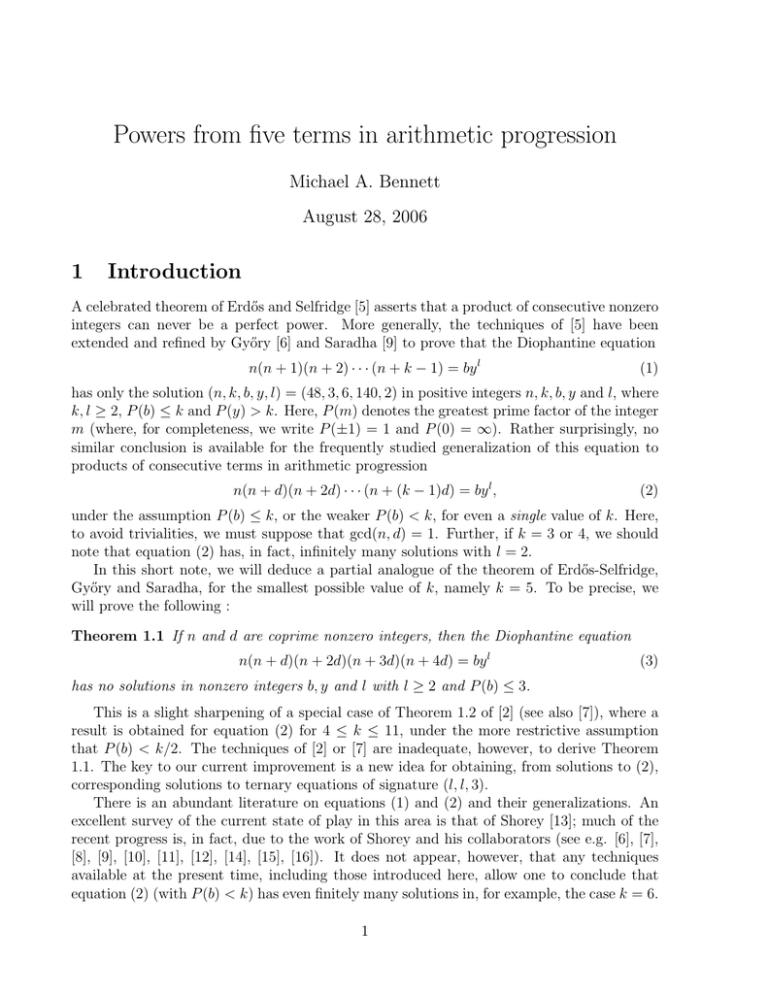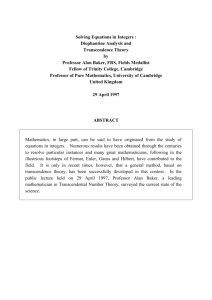Powers from five terms in arithmetic progression 1 Introduction Michael A. Bennett
advertisement

Powers from five terms in arithmetic progression
Michael A. Bennett
August 28, 2006
1
Introduction
A celebrated theorem of Erdős and Selfridge [5] asserts that a product of consecutive nonzero
integers can never be a perfect power. More generally, the techniques of [5] have been
extended and refined by Győry [6] and Saradha [9] to prove that the Diophantine equation
n(n + 1)(n + 2) · · · (n + k − 1) = by l
(1)
has only the solution (n, k, b, y, l) = (48, 3, 6, 140, 2) in positive integers n, k, b, y and l, where
k, l ≥ 2, P (b) ≤ k and P (y) > k. Here, P (m) denotes the greatest prime factor of the integer
m (where, for completeness, we write P (±1) = 1 and P (0) = ∞). Rather surprisingly, no
similar conclusion is available for the frequently studied generalization of this equation to
products of consecutive terms in arithmetic progression
n(n + d)(n + 2d) · · · (n + (k − 1)d) = by l ,
(2)
under the assumption P (b) ≤ k, or the weaker P (b) < k, for even a single value of k. Here,
to avoid trivialities, we must suppose that gcd(n, d) = 1. Further, if k = 3 or 4, we should
note that equation (2) has, in fact, infinitely many solutions with l = 2.
In this short note, we will deduce a partial analogue of the theorem of Erdős-Selfridge,
Győry and Saradha, for the smallest possible value of k, namely k = 5. To be precise, we
will prove the following :
Theorem 1.1 If n and d are coprime nonzero integers, then the Diophantine equation
n(n + d)(n + 2d)(n + 3d)(n + 4d) = by l
(3)
has no solutions in nonzero integers b, y and l with l ≥ 2 and P (b) ≤ 3.
This is a slight sharpening of a special case of Theorem 1.2 of [2] (see also [7]), where a
result is obtained for equation (2) for 4 ≤ k ≤ 11, under the more restrictive assumption
that P (b) < k/2. The techniques of [2] or [7] are inadequate, however, to derive Theorem
1.1. The key to our current improvement is a new idea for obtaining, from solutions to (2),
corresponding solutions to ternary equations of signature (l, l, 3).
There is an abundant literature on equations (1) and (2) and their generalizations. An
excellent survey of the current state of play in this area is that of Shorey [13]; much of the
recent progress is, in fact, due to the work of Shorey and his collaborators (see e.g. [6], [7],
[8], [9], [10], [11], [12], [14], [15], [16]). It does not appear, however, that any techniques
available at the present time, including those introduced here, allow one to conclude that
equation (2) (with P (b) < k) has even finitely many solutions in, for example, the case k = 6.
1
2
The proof of Theorem 1.1
Our proof will, for the most part, follow along similar lines to those in [2] (in particular,
as in [2], our arguments will rely on the fact that a solution to (3) is closely connected to
solutions to related ternary Diophantine equations). Indeed, Theorem 1.2 of [2] implies the
current Theorem 1.1 unless we have, assuming, as we may, that l is prime,
l ≥ 7 and P (b) = 3.
(4)
Let us suppose that we have a solution to equation (3) in nonzero integers n, d, y, b and
l satisfying the conditions of Theorem 1.1 (where we additionally assume, without loss of
generality, that d is positive). From the fact that gcd(n, d) = 1, we may write
n + id = bi yil for 0 ≤ i ≤ 4,
(5)
where bi and yi are integers with P (bi ) ≤ 3. To guarantee that such a representation is
unique, we will further assume that each bi is lth power free and positive. From (4), we may,
in fact, suppose that
max{P (bi )} = 3.
Let us begin by considering the case when P (b2 ) = 3. Then the identity
(n + d)(n + 3d) − n(n + 4d) = 3d2
implies that
b1 b3 (y1 y3 )l − b0 b4 (y0 y4 )l = 3d2 ,
where
gcd (b1 b3 y1 y3 , b0 b4 y0 y4 ) = 1 and P (b0 b1 b3 b4 ) ≤ 2.
We may now appeal to a result of ternary Diophantine equations of signature (l, l, 2); this is
a special case of Theorems 1.1 and 1.2 of [1].
Proposition 2.1 Let l ≥ 7 be prime and α 6= 1 be a nonnegative integer. Then the Diophantine equation
al + 2α bl = 3c2
has no solutions in nonzero coprime integers (a, b, c) with ab 6= ±1.
From this, we conclude that necessarily
b0 = b4 = 2 and y0 = −1, y4 = 1.
This implies that n = −2 and d = 1, contradicting the fact that y 6= 0 in (3).
To complete the proof of Theorem 1.1, it remains to treat the situation when
max{P (b0 ), P (b1 ), P (b3 ), P (b4 )} = 3
(so that either 3 divides both n and n + 3d, or 3 divides both n + d and n + 4d). In this case,
we will apply the “smallest” of a family of identities that one may use to transfer information
about putative solutions to equations of the shape (2), to corresponding ternary equations
2
of signature (l, l, 3) (as opposed to the equations of signature (l, l, 2) or (l, l, l) used in [2]).
The latter may, hopefully, be treated by the methods developed in [3] and [4]. In our case,
we will appeal to the identity
(n + d)(n + d)(n + 4d) − n(n + 3d)(n + 3d) = 4d3 .
This implies the equation
l
l
b21 b4 y12 y4 − b0 b23 y0 y32 = 4d3 ,
whereby, dividing out a suitable power of 2, we find a solution in nonzero integers (a, b, c) to
one of
al + 3β bl = 2α c3 α ≥ 1, β ≥ 3, gcd(a, 3b) = 1,
(6)
or
Aal + Bbl = c3 , AB = 2α 3β , α ≥ 1, β ≥ 3, gcd(Aa, Bb) = 1.
(7)
The first of these equations may be handled by an immediate application of results from
[3]. Indeed, Theorem 1.5 of that paper implies that (6) has no solutions in nonzero integers whatsoever. For equation (7), we argue in a similar fashion. Supposing, renaming if
necessary, that 3 | B, we consider the “Frey” elliptic curve
E = E(a, b, c) : y 2 + 3cxy + Bbl y = x3
Q
with (see Lemma 2.1 of [3]) discriminant 27AB 3 (ab3 )l and conductor 2 · 3δ · p|ab p, for
δ ∈ {0, 1} (where here we suppose that gcd(ab, 6) = 1). From Lemma 3.4 of [3], since l ≥ 7
is prime, the corresponding mod l Galois representation
ρE
l : Gal(Q/Q) → GL2 (Fl ),
on the l-torsion E[l] of E, is unramified outside of 2, 3 and l and necessarily arises from
a cuspidal newform f of weight 2 · 3δ and trivial Nebentypus character. Noting that the
modular curves X0 (N ) have genus 0 for all N dividing 6, we conclude that such a newform
cannot exist. This completes the proof of Theorem 1.1.
References
[1] M.A. Bennett and C. Skinner, Ternary Diophantine equations via Galois representations
and modular forms, Canad. J. Math., (56) 2004, 23–54.
[2] M.A. Bennett, N. Bruin, K. Győry and L. Hajdu, Powers from products of consecutive
terms in arithmetic progression, Proc. London Math. Soc., (92) 2006, 273–306.
[3] M.A. Bennett, N. Vatsal and S. Yazdani, Ternary Diophantine equations of signature
(p, p, 3), Compositio Math., (140) 2004, 1399–1416.
[4] H. Darmon and L. Merel, Winding quotients and some variants of Fermat’s Last Theorem, J. Reine Angew. Math., (490) 1997, 81–100.
3
[5] P. Erdős and J.L. Selfridge, The product of consecutive integers is never a power, Illinois
J. Math., (19) 1975, 292–301.
[6] K. Győry, On the diophantine equation n(n + 1) . . . (n + k − 1) = bxl , Acta Arith., (83)
1998, 87–92.
[7] K. Győry, L. Hajdu and N. Saradha, On the Diophantine equation n(n + d) . . . (n + (k −
1)d) = by l , Canad. Math. Bull., (47) 2004, 373–388.
[8] G. Hanrot, N. Saradha and T.N. Shorey, Almost perfect powers in consecutive integers,
Acta Arith., (99) 2001, 13–25.
[9] N. Saradha, On perfect powers in products with terms from arithmetic progressions,
Acta Arith., (82) 1997, 147–172.
[10] N. Saradha and T.N. Shorey, Almost perfect powers in arithmetic progression, Acta
Arith., (99) 2001, 363–388.
[11] N. Saradha and T.N. Shorey, Almost squares in arithmetic progression, Compositio
Math., (138) 2003, 73–111.
[12] N. Saradha and T.N. Shorey, Contributions towards a conjecture of Erdos on perfect
powers in arithmetic progressions, Compositio Math., (141) 2005, 541–560.
[13] T.N. Shorey, Exponential diophantine equations involving products of consecutive integers and related equations, in Number Theory (R.P. Bambah, V.C. Dumir and R.J.
Hans-Gill, ed.), Hindustan Book Agency (1999), 463-495.
[14] T.N. Shorey, Powers in arithmetic progression, in A Panorama in Number Theory (G.
Wüstholz, ed.), Cambridge University Press, Cambridge 2002, 325–336.
[15] T.N. Shorey, Powers in arithmetic progression (II), in New Aspects of Analytic Number
Theory, Kyoto 2002, 202–214.
[16] T.N. Shorey and R. Tijdeman, Perfect powers in products of terms in an arithmetic
progression, Compositio Math., (75) 1990, 307–344.
4


